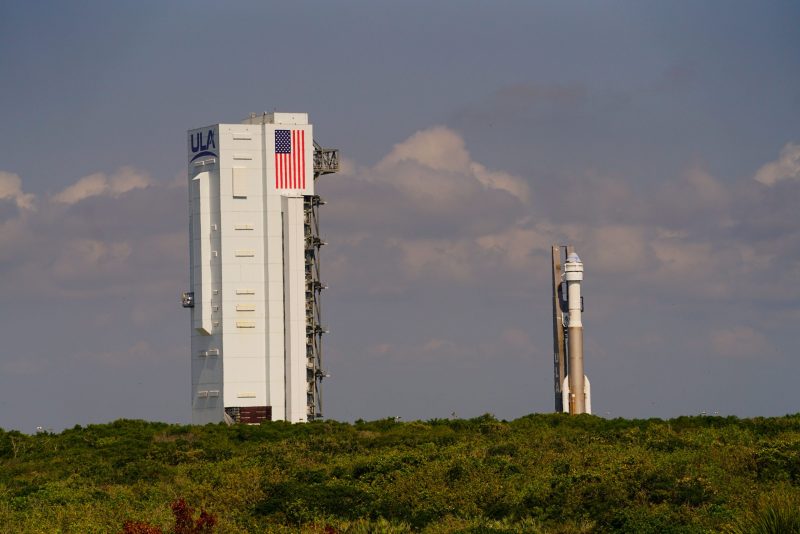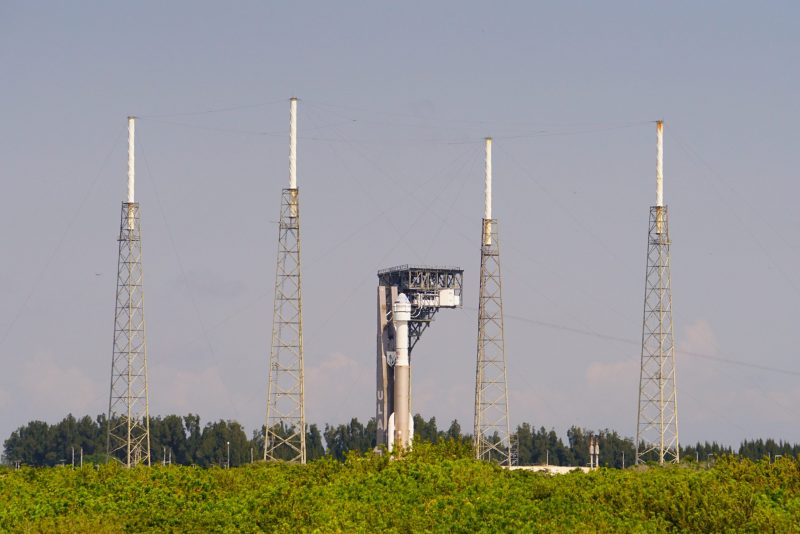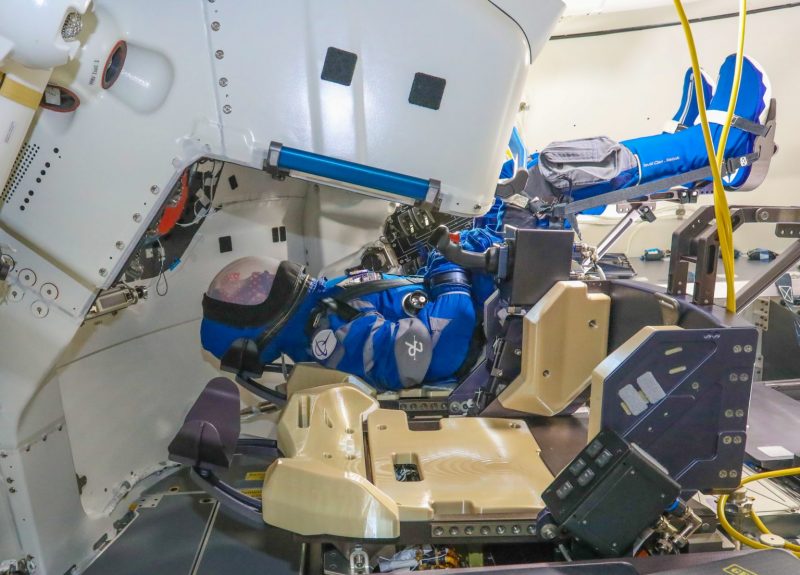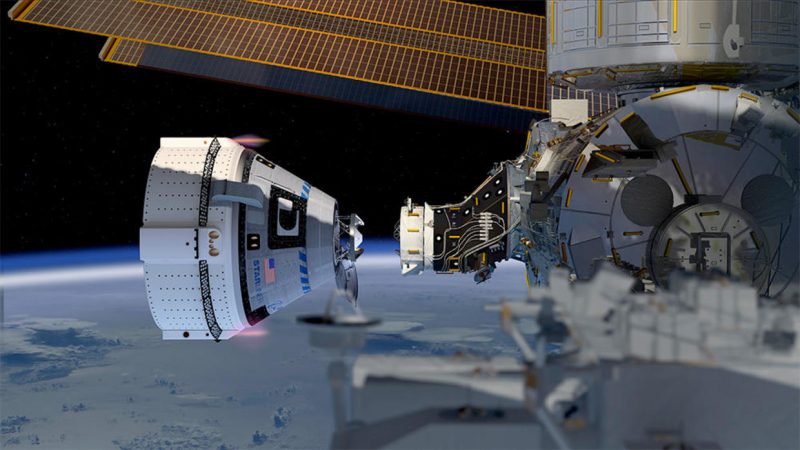Boeing’s Starliner set for launch
After a 45-minute crawl on Wednesday (May 18, 2022) into launch position, Boeing’s Crew Space Transportation (CST)-100 Starliner appears ready for launch this evening. It will be its 3rd attempt – said to be a “critical” and “high stakes” attempt – to rendezvous and dock with the International Space Station. Starliner is a reusable space capsule and will make the test flight uncrewed. The video at top – via NASA Live – will broadcast today’s launch live. NASA TV’s official coverage of the Starliner launch begins at 22 UTC (6 p.m. EDT) on Thursday, May 19, about an hour before the scheduled liftoff. Liftoff is scheduled for 22:54 UTC (6:54 p.m. EDT; translate UTC to your time zone) on May 19.
The broadcast will also be available via NASA’s YouTube channel
Weather forecasts for the launch window show a good chance the ever-changing Florida weather should cooperate, according to NASA’s OFT-2 blog:
For a launch Thursday, meteorologists with the U.S. Space Force 45th Weather Squadron continue to predict a 70% chance of favorable weather. The primary weather concerns for launch day are the cumulus and anvil cloud rules violations during the instantaneous launch window.
Should an issue of any kind prevent Starliner from flying on May 19, a 2nd launch window opens on Saturday, May 21.
EarthSky photos of Wednesday’s rollout
On Thursday morning, Starliner was resting atop one of the most reliable rocket boosters ever manufactured, the United Launch Alliance Atlas V at Cape Canaveral Space Force Station, which is located adjacent to NASA’s main space flight complex, the Kennedy Space Center.
Photographer Greg Diesel Walck is covering the launch for EarthSky.


Starliner launch and follow-up schedule
All times for the coverage schedule are in Eastern Daylight Time, which coordinates to UTC-4.
At about half an hour after the scheduled 6:54 p.m. EDT launch, NASA TV coverage will include the Starliner orbital insertion engine firing, with a post-launch press conference following at 9 p.m. EDT.
At 3:30 p.m. EDT on Friday, May 20, coverage of the rendezvous and docking begins, with docking scheduled for 7:10 p.m. EDT. On Saturday, coverage of the opening of the OFT-2 hatch at the ISS starts at 11:30 a.m. EDT, followed by remarks on the OFT-2 arrival from the Expedition 67 crew.
A full schedule of NASA TV programming is available at NASA Live.
NASA flight engineers onboard the ISS – Kjell Lindgren and Bob Hines – will monitor the three-and-a-half-hour automated approach of OFT-2 before opening the capsule.
OFT-2 will dock with the Harmony module, where it will undergo test operations. The capsule is also carrying 500 pounds (227 kg) of cargo to the ISS that will be unloaded during its five-to-10-day stay on orbit.

Boeing hopes 3rd time’s a charm
On its website, Boeing describes Starliner like this:
Boeing’s Crew Space Transportation (CST)-100 Starliner spacecraft is being developed in collaboration with NASA’s Commercial Crew Program. The Starliner was designed to accommodate seven passengers, or a mix of crew and cargo, for missions to low-Earth orbit. For NASA service missions to the International Space Station, it will carry up to four NASA-sponsored crew members and time-critical scientific research. The Starliner has an innovative, weldless structure and is reusable up to 10 times with a six-month turnaround time. It also features wireless internet and tablet technology for crew interfaces.
The scheduled May 19 launch is Starliner’s 3rd attempt to reach the International Space Station. The first attempt OFT-1, failed when the onboard Mission Elapsed Time (MET) clock malfunctioned, causing a bad burn and a failure to make the correct orbital insertion for docking with the ISS.
The failure of OFT-1 came at the end of 2019, and Boeing engineers thought they were ready for another try in August of last year. That attempt never left the ground, as preflight testing revealed a set of stuck propulsion valves. According to a report by CNBC, Boeing intends to have the valve redesigned. For OFT-2, however, the company applied a quick-fix they hope will keep the valves from failing again. From CNBC:
For this attempt, the company applied a sealant to the valves. But the fix is likely a temporary solution to the issue, which in August saw 13 of the 24 oxidizer valves that control Starliner’s movement in space get stuck after launch site humidity caused corrosion.
The news service Reuters reported on May 8 that Boeing and Aerojet Rocketdyne, which produced the faulty valves, are now at loggerheads over the cause of the failure, with each company pointing a finger at the other. From the Reuters report:
A team of Boeing and NASA engineers is in general agreement that the cause of the stuck valves involves a chemical reaction between propellant, aluminum materials and the intrusion of moisture from Starliner’s humid Florida launch site.
Aerojet engineers and lawyers see it differently, blaming a cleaning chemical that Boeing has used in ground tests, two of the sources said.

Timing of valve dispute bad for Boeing
Timing of the clash with Aerojet Rocketdyne could not have come at a more inopportune moment for Boeing, according to Reuters:
The disagreement, which has not been reported before, comes at a time when Boeing already is scrambling to emerge from successive crises that have hobbled its jetliner business and drained cash.
Boeing has spent around $595 million from its own pockets to correct Starliners problems, leaving the company facing an shrinking profit margin. Development of Starliner was funded by a $6 billion award to Boeing from NASA’s Commercial Crew Program.
Bottom line: Boeing’s Starliner is ready for its 3rd attempt to reach the International Space Station. NASA TV’s official coverage of the Starliner launch begins at 22 UTC (6 p.m. EDT) on Thursday, May 19, 2022, about an hour before the scheduled liftoff. Liftoff is scheduled for 22:54 UTC (6:54 p.m. EDT; translate UTC to your time zone) on May 19.
The post Boeing Starliner high-stakes launch tonight first appeared on EarthSky.
0 Commentaires